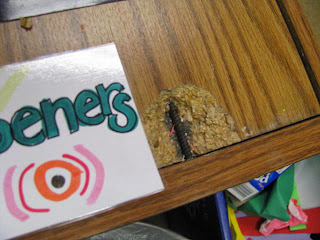Once again, this is a conference lesson find. I didn't actually go to the workshop, I was in another workshop and a friend showed me this after it was over. I don't have any information from the conference presenter (sorry, WhoEverYouAre). It's a simple braiding/cording technique from Japan using 4 colors of string (I use crochet string), 4 strings of each color (16 strings total) and a simple cardboard loom (a circle with 32 slits cut around the side and a hole in the middle). The very first time I did this lesson I drew all the looms out on cardboard and had students cut them out (pretty successful), but I've also had students do the whole loom themselves (not so successful, lots of sloppy ones). I do re-use the looms year after year, and even thought about using pizza circles (from frozen pizza) for this, but I've never tried it. (They're much bigger, more of the string would be wasted, but in a time crunch, I would totally do it).
One of the most in-depth and still user friendly sites I've found on Kumihimo is here. I have to be honest and say I haven't shown students this site, I only use it for background information for myself (mostly just to look cool by telling them "Ya, really tightly braided cords can be used to tow a car." and "Kumihimo were wrapped around sword handles for better grip." You know, the little things that draw their interest) |
| A whole class worth of looms in the drawer. |
The first day that we start this lesson, I draw this on the board:
In theory this helps them to know how to set up their braid, and maybe it does more than I think, but this year I realized I also needed to show them a side view, where it looks like a jellyfish.
Once students are set up and ready to go, it's a simple process. They pick any color to start, and move the left one closest to them to the top:
 |
| See how there are now three green in a row on the top? |
Then move the right one (from the three on the top) down next to it's same color without crossing:
 |
| Green are once again two by two. |
They then move to the next color (in the example up above, her next color is violet) and do the exact same thing. (Left up, right down, turn to next color). That's it. While they're moving strings, a braid is forming from the hole in the middle:
We'll braid until they're long enough to wear around our wrists. This group seemed to "get it" much faster than some of my past groups, and I'm not really certain why (if it's something I did or just how they are), but it's a little lonely in 6th grade right now, because no one needs my help.
Totally unrelated: did you see Mr. E's post about having children of his former students? He had a walker as his picture along with that post. Well, my birthday is this week and they announced it during morning announcements and students in my third grade class today said "Are you 59?" to which I said "My MOM isn't even 59, thanks guys!" and then they said "Are you 19?"
Yep, SURE, I'm 19.
Don't think I can pull that one off with an almost-18-year-old-daughter, but I'm willing to try.


























